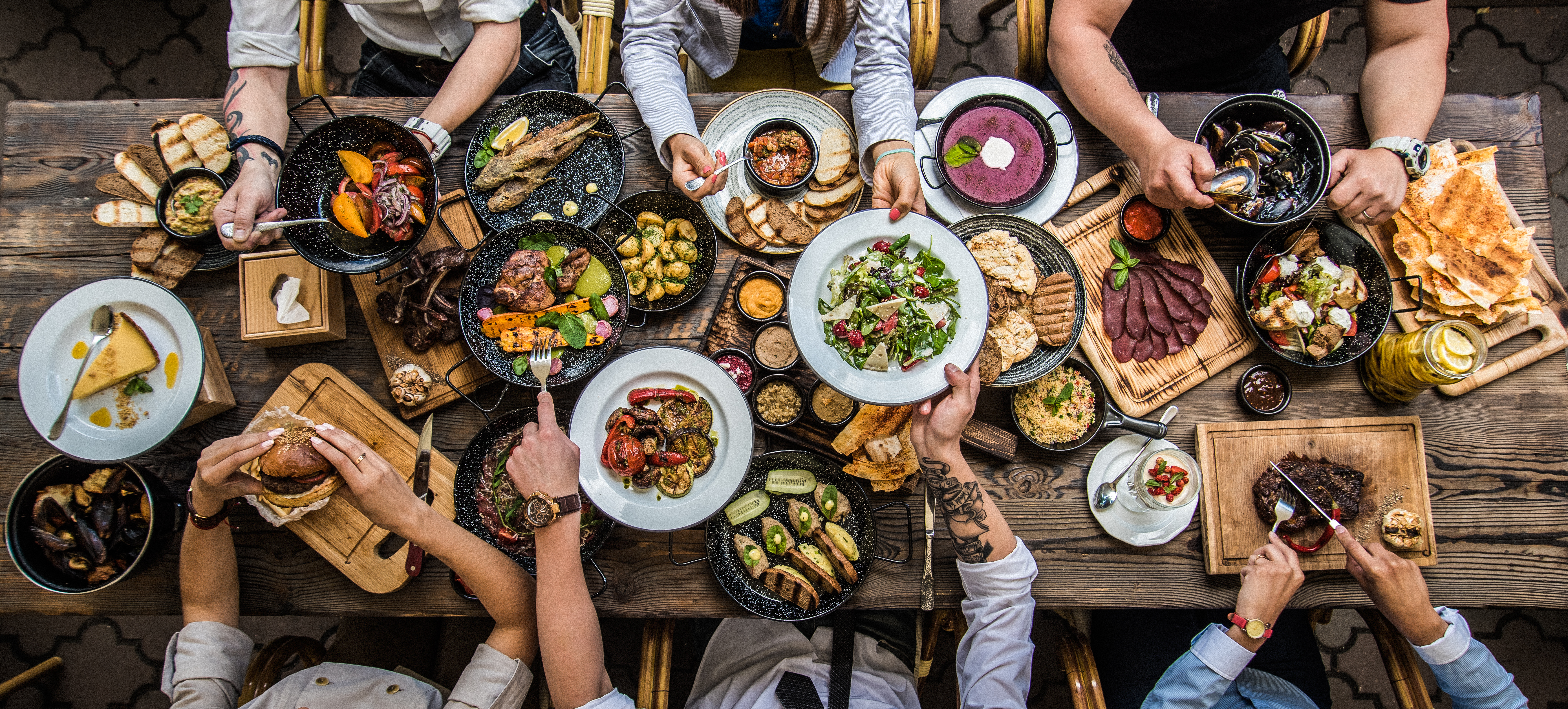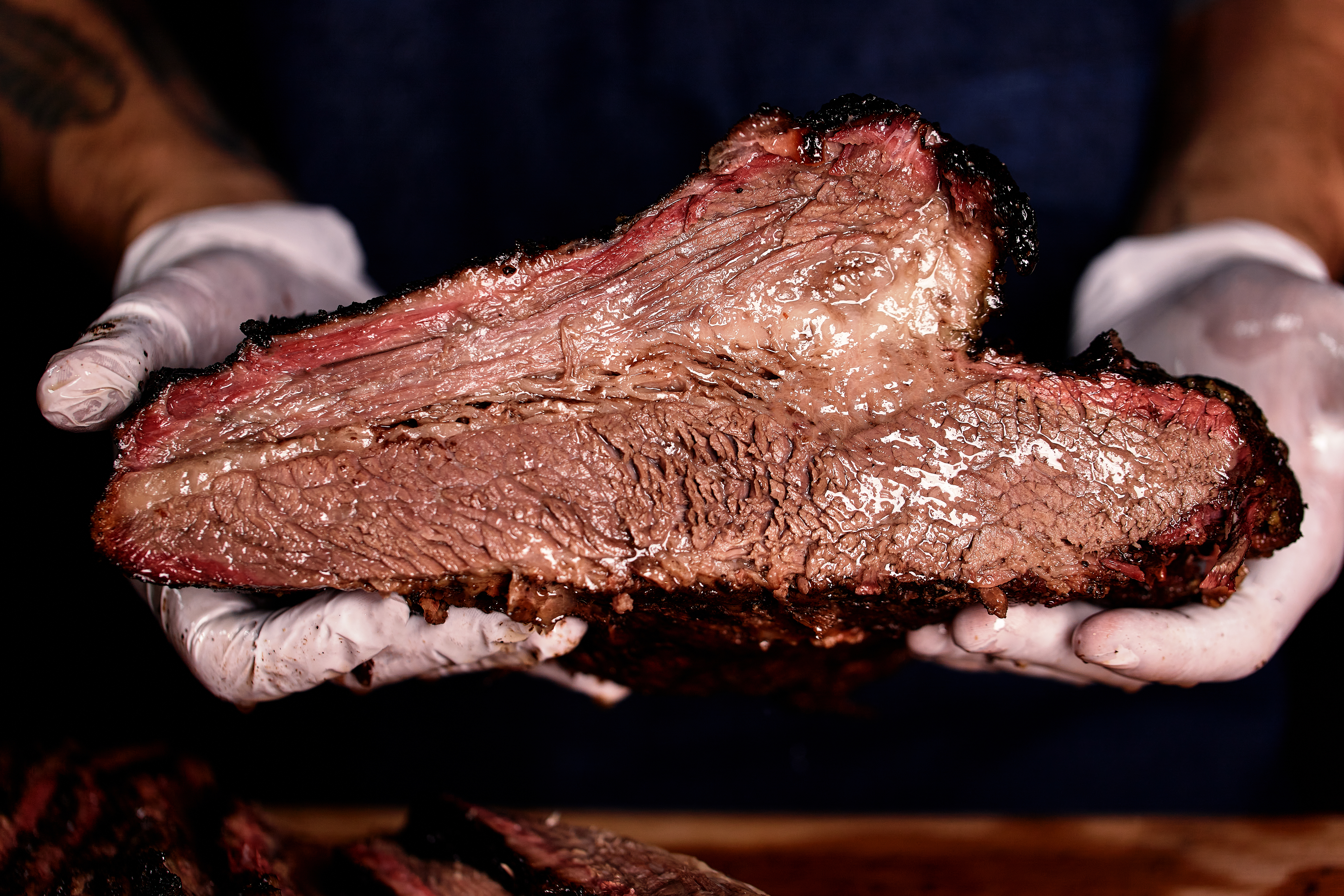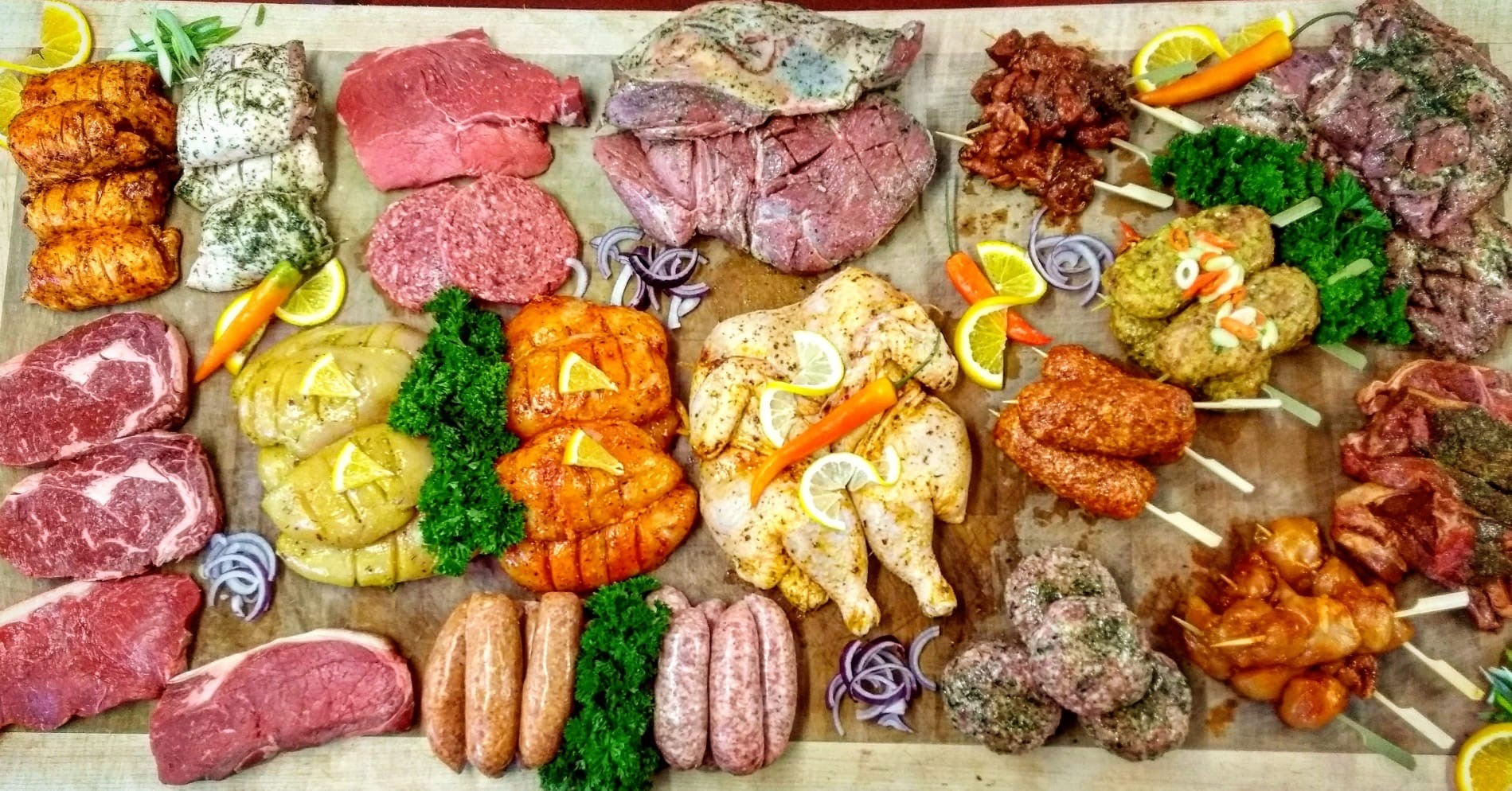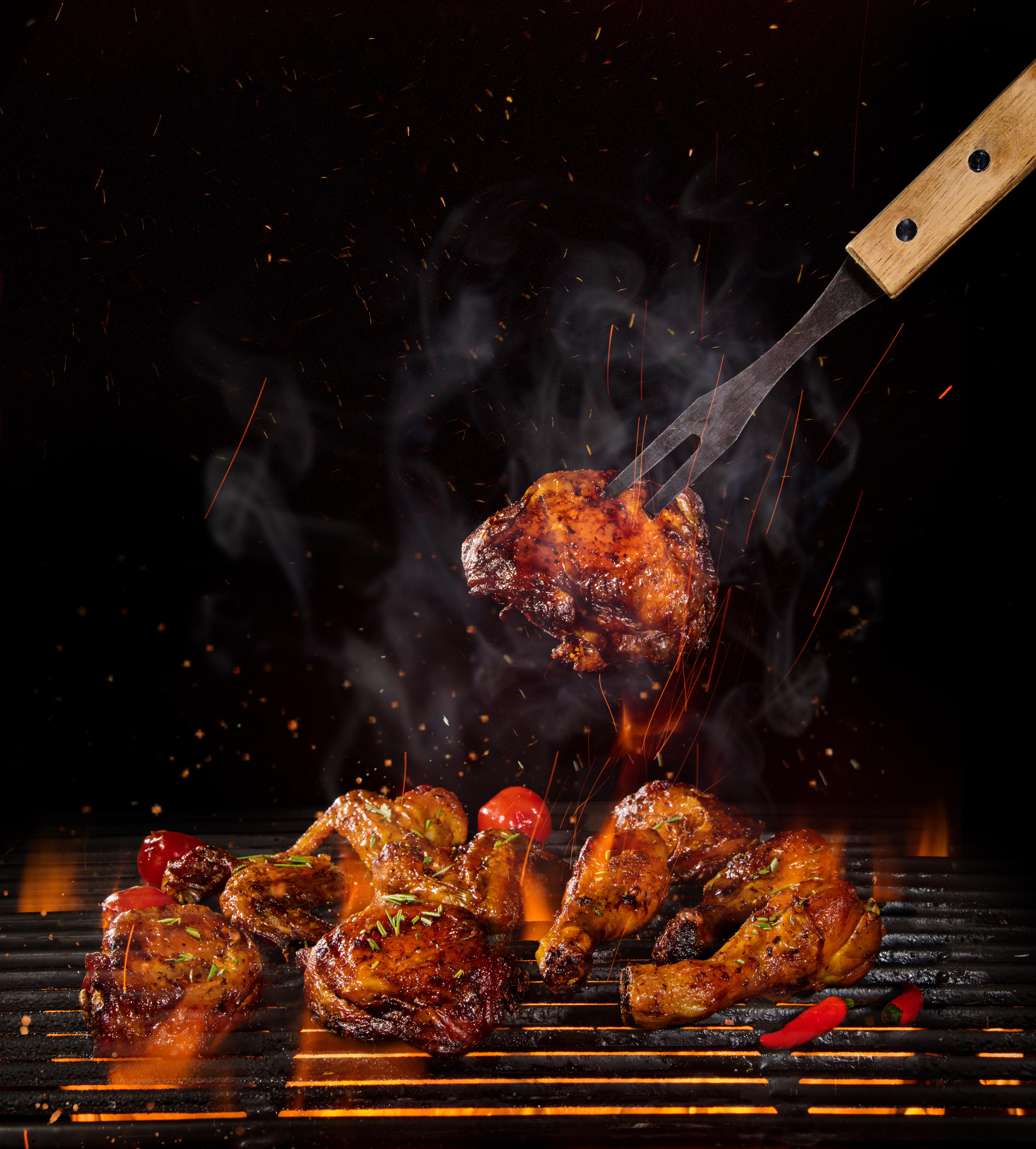Free digital copy
Get Speciality Food magazine delivered to your inbox FREE
Get your free copy
Us Brits love a BBQ. When the mercury drifts above 21C, it’s our cue to shimmy the grill out of the shed, dust the mildew from the garden furniture, and hotfoot it to the nearest farm shop or butcher’s counter to bulk buy piles of meat, floury white baps, ketchup and a few bottles of our favourite tipple.
A typical BBQ haul has historically included burgers, sausages, steaks…perhaps a few skewers of marinated chicken breast.
But, say those in the know, our tastes, and our expectations around what a really decent BBQ looks like, have shifted dramatically in the last five years. Consumers in the UK are becoming more discerning, curious and, crucially, braver when it comes to cooking in the great outdoors.
Social media grill king and cookbook author Christian Stevenson (AKA DJ BBQ) believes barbecuing has never been better in Britain than it is now, and points to lockdown as the defining moment for this method of cooking. “You couldn’t get a Weber 57 Kettle in lockdown,” he says. They were like gold dust. They didn’t even hit the warehouses. Because no one could go out or do anything, a lot of people got into live fire cooking, and they branched out from your burgers and sausages and burnt chicken, and started doing pulled pork and brisket – which is the Holy Grail of barbecue!”
According to Mordor Intelligence, ‘barbecue’ as a category looks set to grow by 3.7% in 2024, while sales of charcoal fired barbecues continue to dominate – accounting for a huge portion of market share (60% in 2022).
James Doyle, head butcher at Hollow Trees Farm Shop, says customers are looking for “convenience, quality, and complementary flavour combinations.”
When designing the butchery counter’s warm weather offering, James says they ensure everything is tried and tested for ease of use, and accompanied by cooking instructions to take out the guess work. This has proved a successful formula for the shop. “We try to approach things from the customer’s perspective,” he says. “Not only do we want our product to be good value and using the highest quality meat from our farm – we want them to look inviting too. We often imagine what would pair well with other products available in the farm shop, such as locally produced condiments and freshly baked bread, so only one trip out is needed to gather all the meal essentials.”
Greg Lewis, development chef at Sykes House Farm, says more consumers are using their BBQ throughout the year, rather than just in high spring and summer, with demand for grill cuts expanding into autumn and winter. “People have also realised if they don’t want to go and cook outside, they can even get good results in their air fryer,” he says.
Alistair Angus of Thurston Butchers agrees, saying barbecuing today is far removed from what he experienced in childhood. “The weather would hit 25C, my parents would wheel out the barbecue. But they didn’t think of barbecuing as a technique. Don’t get me wrong, summer is mad for us, and people do tend to cook more in those months, but then we are also getting them coming in all-year-round for barbecue products and joints – even for Christmas Day!”
Brits are embracing American BBQ culture like never before, Alistair adds, saying this is a fast-growing trend in butchery. “People are cooking with larger cuts like a traditional American smokehouse would do. Sales of smokers have gone up no end, and we’ve got customers coming in wanting a Boston butt. Five to 10 years ago you wouldn’t have heard of that in this country!” Sales of brisket, short ribs and tomahawks have also risen. Customers are after “big statement sharing pieces. Rather than going into a butcher just to get a few sausages, people will do a whole brisket, slow smoked and carved into bits like a sharing platter.”

Alistair says he’s seen consumers’ confidence go “through the roof, whereas before they would have veered away from anything large.”
James is also seeing an uptick in American-style grilling, saying it’s “definitely opening up the barbecue market” and adding that “provenance is key. Customers aren’t afraid to experiment, and we love to see how they turn a whole homegrown beef fillet or impressive tomahawk into a sharing barbecue feast for friends and family.”
Christian is delighted more people are cooking with cuts like brisket. “They’re sourcing these American-style cuts, and getting good results, putting a really nice crust on the outside. The other thing I’m seeing is people are taking the main event outdoors. Instead of doing a Sunday roast inside, they’ll take a whole leg of lamb or a topside of beef and do it outside using the direct grill method.”
Experimentation is one of the key trends and major factors driving consumer buying patterns, Christian adds. “Two years ago the big thing was the Oklahoma-style smash burger where you get a whole bunch of thinly sliced onions on a ball of meat and smash them in, then hit with yellow mustard. I’m seeing people trying new things and getting more adventurous, and we’re seeing more foods from different cultures, like birria tacos – they were so hot last year – and burgers and smoked meats with dips, gravies and consommés.”
Another factor butchers and farm shops should take into account this year is the ‘low and slow’ movement. Greg laughs, saying, “Cows haven’t changed that much, but things like brisket are getting more popular every year. And forerib of beef is ideal to cook slowly, but you’ve got to talk to customers to understand what they need. If you’re selling them a lean fillet and they go away and cook low and slow, it’s not going to give them the results they want. Pork shoulder is great for this, or lamb shoulder or butterflied leg.”

When it comes to meat choices, ‘bigger is better’ according to butchers and BBQ experts. Greg says the cut of steak customers are looking for changes almost every year. “At the moment I’m seeing a lot more sales of things like picanha steaks,” he reveals, adding that people want “a bit more fat – definitely more than 10 years ago when it was all about cooking lean. The picanha is the cap of the rump, with a layer of fat around the top. It’s a really tender steak, and until now it’s been more seen as a South American thing. But it’s very on trend here. We sell so much of it now we end left with the sirloin or rump steak!”
Greg says there’s still an appetite for ribeye steaks – though increasingly he’s being asked for them on the bone, or for tomahawks. And steaks are no longer limited to just beef. “Pork steaks and pork on the bone is taking off,” he adds. “We sell an awful lot of those, and we’re talking loads of pork tomahawks and pork ribeyes.”
Pork is “cheaper, but it’s been underused over the years. People tend to think about pulled pork, but there’s so much more to it,” Greg says. There is still a bit of educating to be done at the counter, though, he continues, saying many people are scared of cooking pork, or serving it pink. “We do training days here where we show you can have pork a little bit pink. Medium rare is a bit weird, but a little pink is absolutely fine, and more people are learning that.”
Greg points out that, at just a few pounds, compared to upwards of £10 or more for beef, pork steaks present a great, affordable opportunity to lure shoppers who want something that’s a cut above, out of the supermarket, and into the fine food realm.
Christian says following on from the popularity of hanger steaks, 2024 is all about tender bavettes and flanks. “We’re starting to see bavettes not only in butcher shops, but you can order them on Ocado now!” There appears to be, he says, more interest in the belly of the cow, fattier pieces of meat, and steaks sliced off the shoulder. “I love everything around that shoulder,” he enthuses. “It works a bit harder, and there’s more flavour there.
“When you cook it down slowly, all that cartilage and fat melts into butter from within.” Butchers, Christian says, are being asked more and more often for bespoke cuts – many of them usually seen as the ‘butcher’s treat’ - such as the ‘rump heart’ (a fillet cut from the rump), and the ‘spider steak’ which is “super tender and perfect for asado tacos. That Mexican style is getting more popular. I don’t think you can beat beef neck either for the flavour.”

In addition to steak, sausages, burgers and chicken will always be the “bread and butter of the barbecue,” says Alistair. “We rarely have an order that doesn’t include them. But we’ve noticed whereas it was all burgers and sausages 10 years ago and it was hard to get people to buy kebabs, they are shopping differently now. They are trying new things.” Alistair has seen a noticeable steer towards marinated products that are easy to cook, such as thin pork steaks and marinated chicken breasts. “Those are our biggest sellers. Also pork belly strips that have been marinated. Anything that’s easy, taking out a bit of the thought process, works really well.” The shop has a rotation of around 25 to 30 different marinades, from spicy to sweet, to herbal, so there’s always something for everyone. And Alistair sees this as the direction of travel going forward. Simple-to-cook meal solutions.
Over at Hollow Trees, James says the team gets through an enormous amount of their best pork sausages and best burgers, made with the farm’s own meat, but “another product which always sells well during the barbecue season is our lavender pork ribeye. It’s a unique cut and flavour combination. Charring from the hot grill brings a smoky depth to the flavour, complimenting the fragrant herby marinade which has made its way into the meat. It’s a real showstopper.”
Cheaper cuts of chicken also remain popular, says Greg – particularly wings. “I think people have a bit more appreciation for them now,” he explains, putting this down to, like steaks, consumers seeking out more fat in their meat to maximise on flavour and allow for traditional lower, slower cooking techniques.
“People have also become better cooks,” Greg adds. “With chicken thighs, they used to put them in the oven forever and they’d go dry, but now they seem to be treating them with respect. They have so much flavour. You can bat them out until they’re thin so the skin goes crispy. They’re much more versatile than a breast.”
When it comes to sausages, Greg says he’s finding customers want greater meat content and, crucially, they don’t want to be fobbed off with higher prices just because it’s ‘barbecue season’.
“A lot of places keep the prices the same, but drop the meat content for barbecue sausages. We’ve gone the other way to keep the meat content high. I’d rather pay 50p more for great sausages.” Taking it a step further, Greg has developed a range of frankfurters for his counter as demand for gourmet hot dogs grows, and consumers look for better quality and less additives in these types of products. They appeal to children and adults alike and “they really do fly all-year-round”.

In addition to American smokehouse-style cooking taking off in a big way, Asian grills (such as Korean BBQ) are having their day. In fact, in 2023 Chinese barbecue became so popular that TikTok accounts putting a spotlight on the city of Zibo and its outdoor grilling techniques, led to it gaining the moniker ‘the holy land of barbecue’. Officials began to lay on special BBQ trains to deal with the influx of visitors that ensued, and new food courts sprung up to meet the unexpected demand. Most popularised are the city’s shawarma-style charcoal-cooked meats (usually pork belly) served with wraps, crushed peanuts, spring onions, salad and various dips and dressings on the side for dunking – all of which feed into the kind of sharing, experiential dining moments consumers seem to be craving.
“Oriental flavours were really big last year,” Greg agrees, saying Chinese and Thai marinades were popular with his customers. “Shortribs and Jacob’s ladders take Oriental flavours really well. And chicken wings can be braised in a punchy Korean or Chinese-flavoured broth, cooled overnight in the stock, dried off and put on the barbecue to get some smoke through.”
“We sell a lot of Chinese-style pork ribs, pork steaks and kebabs,” says Alistair. “I think ‘Chinese’ as a flavour in butchery, was invented in the 70s. And it’s a really good flavour. Another one worth trying is sticky maple. That caters for everyone and is a real crowd pleaser.”
Christian is seeing more a prevalence of Middle Eastern and North African spicing coming through on the grill. “I think, a few years ago, it was all about the classic American spice rub. But now people are starting to find spices and varieties that weren’t so widely available. They want to try those North African vibes of coriander and cumin, and earthier flavours. And there’s so much more choice in chillies – I’m always buying dried chillies. Britain is now just such a melting point of all these different countries and cultures which is what makes the barbecue scene here so vibrant and exciting.”
As you’ve already read, charcoal is ruling the BBQ market in the UK, and one of Christian’s biggest pieces of advice for garden centres, food halls and farm shops is to make space to sell charcoal BBQs and their associated kit if you have room. Or at the least choose the highest quality charcoal and charcoal briquettes, placing them in a prominent position in store for customers to grab and go. Charcoal, he says, is incomparable to gas, and more people are discovering this for themselves. “I learnt to cook on a gas grill when I was five, but when I got into charcoal there was no going back,” he says. “I prefer the flavour you get from it, and the dynamic heat. You’re never going to get that intense heat and rich char from gas. Also, there’s no flavour in gas!”
Christian suggests aligning yourself with growing consumer interest in sustainability by giving thought to your charcoal supply. He uses Oxfordshire produced Whittle and Flame’s charcoal, made from ash trees affected by dieback. “Charcoal is the best for that smoky flavour as it releases the notes from the tree sugars, and using charcoal you can be cooking in six or seven minutes,” he says. “Also, you can cook direct or indirect, putting the charcoal in one corner if you’re slow cooking. It’s all about zoning.”
Stocking wood chips for the increasing number of domestic food smokers sitting in people’s gardens is a good idea too, Christian says, with a plea to go for wild wood, from fruit trees where possible when it comes to both charcoal and chips. “Use sustainable British hardwood and make sure it’s very seasoned. You want 17% moisture rating or less, otherwise you can get some acrid smoke. There are certain trees I do use and certain ones I don’t. I love wild cherry, sweet chestnut, ash, alder and oak, and all fruit trees.” Apart from wood from commercially-grown and sprayed apples he adds. “I don’t want that wood to cook my food!”
No BBQ or al fresco eating occasion is complete without sauces, relishes and pickles. As a good all-rounder, Alistair recommends Stokes Bloody Mary Ketchup. “It’s got vodka and Tabasco and Worcestershire sauce in it. That combined with ketchup is amazing. I’m also noticing loads of people buying into rubs. That’s definitely something we’re looking to get more of in the lead up to summer.”
Selina Talbot at Cottage Delight says retailers with their own cafe or restaurant are in a unique position to showcase the versatility of sauces, chutneys and relishes as the warmer weather comes around. Having an onsite eatery means customers can sample and experience key lines, which could clinch those sales. Maybe offer a hot sauce or barbecue sauce at the breakfast table alongside a full English, or try something different in your sandwich range.
Seeing growth in the table sauce category, the brand has just launched its Smoky Chipotle Barbecue Sauce. “It’s smoky, with a bit of spice, and is really geared up to go in burgers and hot dogs, or could be used as a glaze on ribs or wings,” Selina says. It sits alongside Cottage Delight’s big barbecue sellers – the Hickory Smoked Barbecue Sauce, Peppered Steak Sauce, and Gourmet Burger and Gourmet Hot Dog Sauce, which are a huge hit with customers. “The Gourmet Burger Sauce is a bit like a Big Mac sauce. The same sort of consistency, texture and flavour, but obviously much more premium,” adds Selina. “We’ve been speaking to our customers, and they say our sauces are really strong, and they haven’t found anyone else that has the quality we do.”
This year she says consumers are looking for something a bit different for the barbecue table and confirms hot sauces and chilli sauces (which can also be used to pep-up braises, chilli con carne and other slow-cooked dishes) perform consistently well for the brand.
Dressings are another consideration for your ambient aisles – something to bring life to the salads that prop up barbecue food. Brits’ top five favourites are, apparently, potato salad, coleslaw, pasta salad, green salad with French dressing, and Caesar salad. Though many home cooks delight in making their own dressings, there are equally enormous numbers who prefer the convenience of something pre-made. And if they’ve gone to the effort of selecting prime cuts for the grill, only the best will do when it comes to the salad bowl.
Philip Marx of RH Amar, suggests Cardini’s Caesar Dressing could prove popular this year – especially as it’s the 100th anniversary of the Caesar salad. As legend has it, he says, “Caesar Cardini was an Italian immigrant who had a restaurant in San Diego just before prohibition was enacted in America. When that happened, he moved the restaurant over the border to Tijuana so he could serve drinks with the meals, and Hollywood A listers amongst others, would visit his restaurant. One Independence Day he got a big influx of people, more than he expected, and used what ingredients he had to create a salad. And there, in front of everyone, he made the first Caesar salad.”
Cardini’s Caesar Dressing is made to the authentic recipe (no anchovies in sight), and contains no artificial additives or preservatives. The product has seen significant growth in the last few years, being up 27% in 2023 against 2021 at RH Amar, which is creating a buzz of activity around this dressing for 2024, including in-store promotional plans.